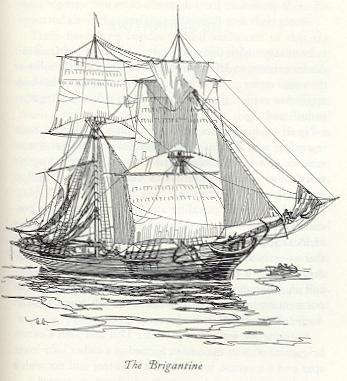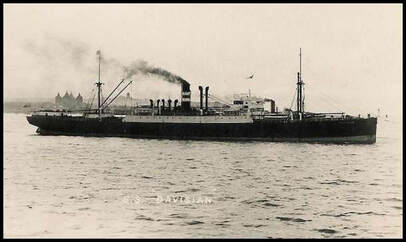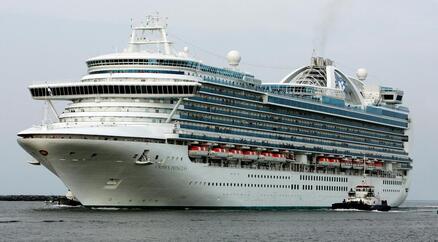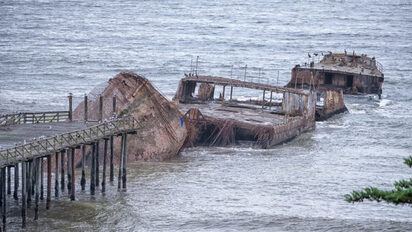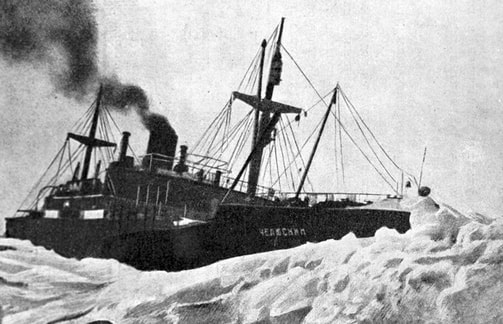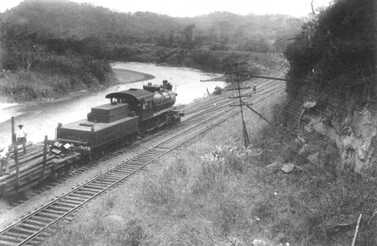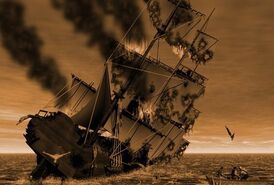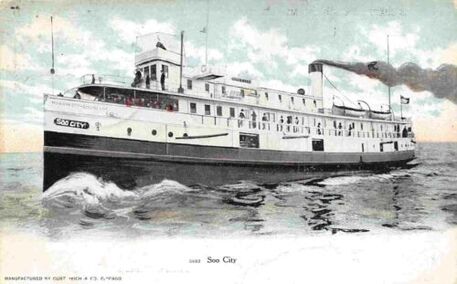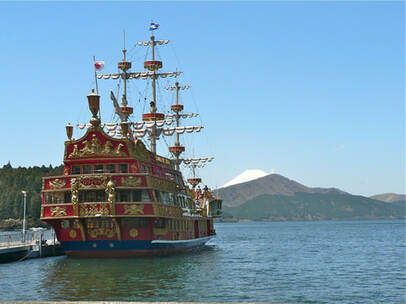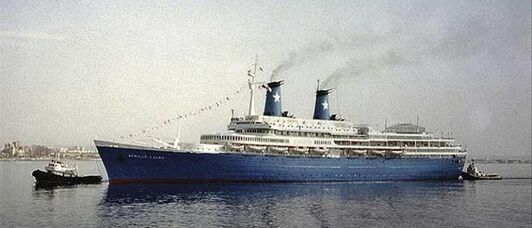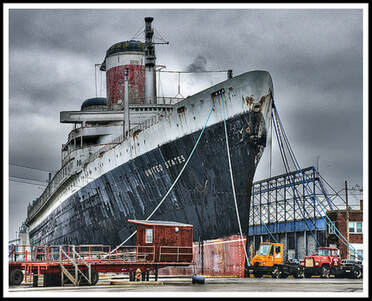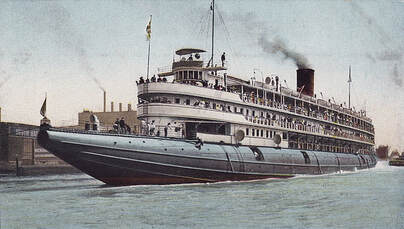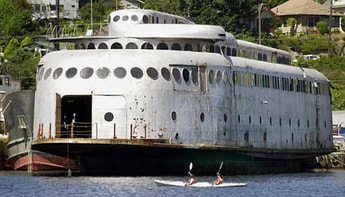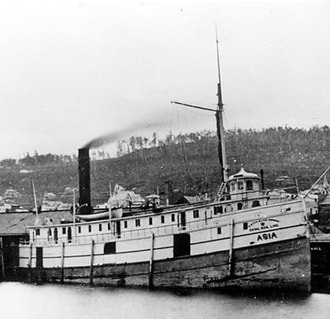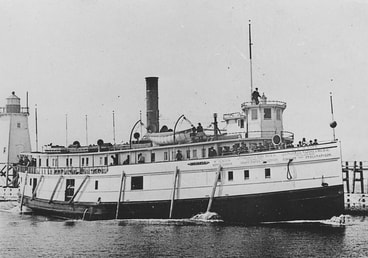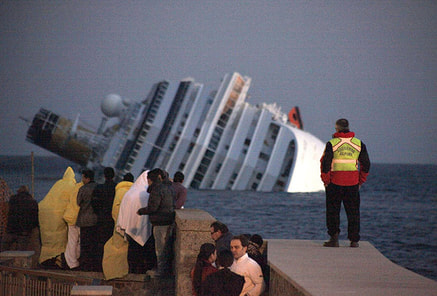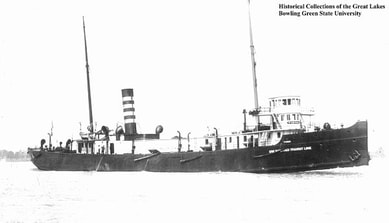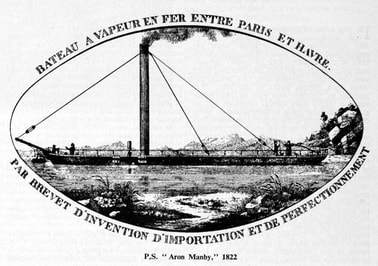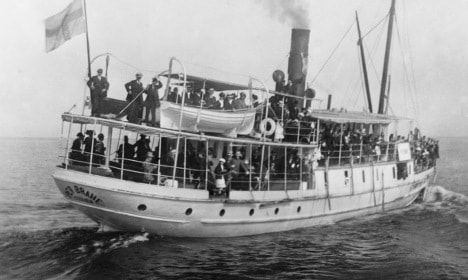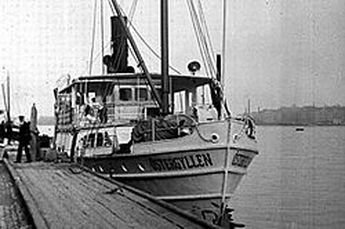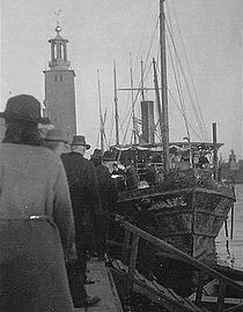Lake Eries Legendary Monsters of Shipwreck
People who live on or have sailed the Great Lakes know how fast storms can develop and catch fishermen in small craft as well as sailors on the large ships unaware. Lake Erie, the shallowest of the lakes, is said to be the most dangerous of them all. Summer storms, which sometimes can emerge from almost out of nowhere, can turn that lake into a frenzy that has claimed many a fine ship and its crew. There are mysteries about Lake Erie; stories of lost ships, men and even aircraft that have caused many writers and conspiracy theorists to speculate that this lake has its own version of the infamous Bermuda Triangle. And then there are the stories told by the old men who claim to have seen or at least heard about a monster living in those waters referred to as the Storm Hag. Another eerie legend about Lake Erie involves the appearance of a ghostly black dog.
People who live on or have sailed the Great Lakes know how fast storms can develop and catch fishermen in small craft as well as sailors on the large ships unaware. Lake Erie, the shallowest of the lakes, is said to be the most dangerous of them all. Summer storms, which sometimes can emerge from almost out of nowhere, can turn that lake into a frenzy that has claimed many a fine ship and its crew. There are mysteries about Lake Erie; stories of lost ships, men and even aircraft that have caused many writers and conspiracy theorists to speculate that this lake has its own version of the infamous Bermuda Triangle. And then there are the stories told by the old men who claim to have seen or at least heard about a monster living in those waters referred to as the Storm Hag. Another eerie legend about Lake Erie involves the appearance of a ghostly black dog.
The Wreck Of The Brig Annie Jane
A concrete monument still stands on a bluff on the Island of Barra in the Outer Hebrides, marking the place where the bodies of 348 victims of the wreck of the sailing ship Annie Jane were buried in a single pit in the fall of 1853. That wreck just off the coast of Scotland is still marked among the worst shipwreck disasters in seafaring history. While other wrecks may have claimed nearly as many, if not more lives, few have produced a story of the kind of terror and consternation experienced by this one.
A concrete monument still stands on a bluff on the Island of Barra in the Outer Hebrides, marking the place where the bodies of 348 victims of the wreck of the sailing ship Annie Jane were buried in a single pit in the fall of 1853. That wreck just off the coast of Scotland is still marked among the worst shipwreck disasters in seafaring history. While other wrecks may have claimed nearly as many, if not more lives, few have produced a story of the kind of terror and consternation experienced by this one.
German Raider Skipper Charged In Davisian Incident
War today is not a gentleman’s game. But in 1940, in the early days of World War II, the skippers of German submarines and raiders of the sea were still respectful of human life. There was a strange practice of hailing the target and allowing everyone on board to abandon ship before it was sunk at sea. One such incident involved the German commerce raider Widder and the British freighter Davisian when the two vessels met on the North Atlantic on Oct. 7 and the Davisian was sunk.
War today is not a gentleman’s game. But in 1940, in the early days of World War II, the skippers of German submarines and raiders of the sea were still respectful of human life. There was a strange practice of hailing the target and allowing everyone on board to abandon ship before it was sunk at sea. One such incident involved the German commerce raider Widder and the British freighter Davisian when the two vessels met on the North Atlantic on Oct. 7 and the Davisian was sunk.
Are The New Cruise Ships Top Heavy?
While this writer is not an expert on ship design, he does know when a ship looks peculiarly out-of-balance. And a lot of the new cruise liners coming off the ways, stacked with decks that make them look like floating luxury hotels, appear dangerously top heavy. Thus it was no surprise to me when the new 19-deck Carnival Cruise liner Crown Princess, came dangerously close to capsizing during its first full cruise from New York to Grand Cayman and back again.
While this writer is not an expert on ship design, he does know when a ship looks peculiarly out-of-balance. And a lot of the new cruise liners coming off the ways, stacked with decks that make them look like floating luxury hotels, appear dangerously top heavy. Thus it was no surprise to me when the new 19-deck Carnival Cruise liner Crown Princess, came dangerously close to capsizing during its first full cruise from New York to Grand Cayman and back again.
Concrete Ship Palo Alto
The remains of a ship that has attracted visitors to the Pacific shore at Aptos, California was finally torn asunder during the winter storms that recently swept the state. What few people know was that it was the remains of the Palo Alto, an experiment in building concrete ships. A shortage of steel during World War I prompted Congress to appropriate money under an Emergency Fleet bill to have 24 concrete ships constructed for the war effort. The Palo Alto was one of three such concrete ships built by the San Francisco Shipbuilding Co. at the U. S. Naval Shipyard at Oakland in 1918.
The remains of a ship that has attracted visitors to the Pacific shore at Aptos, California was finally torn asunder during the winter storms that recently swept the state. What few people know was that it was the remains of the Palo Alto, an experiment in building concrete ships. A shortage of steel during World War I prompted Congress to appropriate money under an Emergency Fleet bill to have 24 concrete ships constructed for the war effort. The Palo Alto was one of three such concrete ships built by the San Francisco Shipbuilding Co. at the U. S. Naval Shipyard at Oakland in 1918.
Historic Russian Steamship Chelyuskin Found
The Russian icebreaker Chelyuskin made headlines in July, 1933, when it got caught in the frozen Arctic ice and then sank in the Bearing Sea after the shifting ice floes crushed its hull. The ship steamed off that summer from the port of Murmansk in an attempt to break its way through the ice fields to Vladivostok, in the Pacific Ocean, and prove that cargo ships could safely take a northern route instead of traveling all the way south around Asia. It didn't make it.
The Russian icebreaker Chelyuskin made headlines in July, 1933, when it got caught in the frozen Arctic ice and then sank in the Bearing Sea after the shifting ice floes crushed its hull. The ship steamed off that summer from the port of Murmansk in an attempt to break its way through the ice fields to Vladivostok, in the Pacific Ocean, and prove that cargo ships could safely take a northern route instead of traveling all the way south around Asia. It didn't make it.
The Panama Railroad Steamship Company
Before the Panama Canal was built people wishing to travel from New York to California either went by horse and covered wagon, or they boarded a ship for a long passage south around the southern tip of South America. Either way proved to be a long and often dangerous journey. It was inevitable that a canal would be constructed across the 51-mile-wide isthmus of Panama. In the meantime, the Panama Railroad Steamship Company attempted to fill that gap. This company was incorporated in New York in 1849 for the purpose of building and operating a railway across the Isthmus of Panama and providing ports at both ends for ships load and unload merchandise and passengers. This service began in 1855.
Before the Panama Canal was built people wishing to travel from New York to California either went by horse and covered wagon, or they boarded a ship for a long passage south around the southern tip of South America. Either way proved to be a long and often dangerous journey. It was inevitable that a canal would be constructed across the 51-mile-wide isthmus of Panama. In the meantime, the Panama Railroad Steamship Company attempted to fill that gap. This company was incorporated in New York in 1849 for the purpose of building and operating a railway across the Isthmus of Panama and providing ports at both ends for ships load and unload merchandise and passengers. This service began in 1855.
Legend Of Fiery Ghostly Ship Haunts Rhode Island Coast
There is a story that shoreline residents near Cranston, Rhode Island, sometimes still see the fiery glow in late December of an Eighteenth Century sailing vessel as it runs up on the rocks off nearby Block Island. A poem Wreck of the Palatine by John Greenleaf Whittier tells a story of how people on Block Island lit false signal lights to lure a ship into the rocks and then murdered the passengers and crew before plundering the wreck. They later burned the wreck. Since that event, it is said that people in the area are still haunted by the appearance of a blazing ghost ship that appears on moonless nights between Christmas and New Years.
There is a story that shoreline residents near Cranston, Rhode Island, sometimes still see the fiery glow in late December of an Eighteenth Century sailing vessel as it runs up on the rocks off nearby Block Island. A poem Wreck of the Palatine by John Greenleaf Whittier tells a story of how people on Block Island lit false signal lights to lure a ship into the rocks and then murdered the passengers and crew before plundering the wreck. They later burned the wreck. Since that event, it is said that people in the area are still haunted by the appearance of a blazing ghost ship that appears on moonless nights between Christmas and New Years.
Strange Disappearance Of The Soo City
After a successful career on the Great Lakes, the passenger steamer Soo City met its end in a cloak of mystery on the North Atlantic. Nineteen sailors disappeared with the boat sometime between Nov. 14, 1908, when it left Quebec for a fateful trip down the Atlantic seaboard, and Dec. 4, when wreckage began washing ashore near North Sidney, Nova Scotia.
After a successful career on the Great Lakes, the passenger steamer Soo City met its end in a cloak of mystery on the North Atlantic. Nineteen sailors disappeared with the boat sometime between Nov. 14, 1908, when it left Quebec for a fateful trip down the Atlantic seaboard, and Dec. 4, when wreckage began washing ashore near North Sidney, Nova Scotia.
Vasa – The Magnificent Top-Heavy Warship
Back in the Seventh Century Sweden and Poland were at war, and their navies were fighting one another on the Baltic Sea. The king of Sweden, Gustavus Adolphus, ordered the construction of an armada of new and mighty warships. Among the largest and most powerful of these great gunboats was the Vasa. The Vasa was designed to be the mightiest and most magnificent warship ever, with 64 guns on two gun decks. The top gun deck also was located high over the main deck thus giving the warship an advantage of height over an enemy vessel. Or so it was theorized. It made the ship top-heavy. When they opened the gun ports and rolled those big guns out for a salute to the king after the ship was launched, it capsized for lack of enough ballast.
Back in the Seventh Century Sweden and Poland were at war, and their navies were fighting one another on the Baltic Sea. The king of Sweden, Gustavus Adolphus, ordered the construction of an armada of new and mighty warships. Among the largest and most powerful of these great gunboats was the Vasa. The Vasa was designed to be the mightiest and most magnificent warship ever, with 64 guns on two gun decks. The top gun deck also was located high over the main deck thus giving the warship an advantage of height over an enemy vessel. Or so it was theorized. It made the ship top-heavy. When they opened the gun ports and rolled those big guns out for a salute to the king after the ship was launched, it capsized for lack of enough ballast.
Hard Luck Ship Achille Lauro
The passenger liner Achille Lauro is best remembered as a ship hijacked by Palestinian terrorists and two days of highly publicized drama at Alexandria, Egypt in 1985. It was all highlighted by the murder of American wheelchair-bound passenger Leon Klinghoffer, whose body was thrown overboard in the midst of the crisis. The shipboard drama ended when the hijackers were surrendered to a representative of the Palestine Liberation Organization on Oct. 9, two days after the ship was seized. But there is much more to the story . . .
The passenger liner Achille Lauro is best remembered as a ship hijacked by Palestinian terrorists and two days of highly publicized drama at Alexandria, Egypt in 1985. It was all highlighted by the murder of American wheelchair-bound passenger Leon Klinghoffer, whose body was thrown overboard in the midst of the crisis. The shipboard drama ended when the hijackers were surrendered to a representative of the Palestine Liberation Organization on Oct. 9, two days after the ship was seized. But there is much more to the story . . .
Saving The SS United States
When launched in 1952 the SS United States was among the last and finest luxury passenger liners of its type built for trans-Atlantic passenger and cargo service. With a sleek 990-foot-long all-aluminum hull and powered by four Westinghouse steam turbines driving separate massive propellers, the ship reached speeds of 44 miles per hour thus setting speed records for trans-Atlantic crossings. This great liner had been docked and slowly falling to ruin, mostly at Pier 82 on the Delaware River in Philadelphia since 1996. There have been numerous buyers since the vessel went out of service. Plans included refurbishing the vessel for Caribbean cruises, converting it into a hotel and dining facility, using it as a gambling casino, restoring it as a marine museum, and finally, just scrapping it. All of the plans have fallen through over the years, mostly because of the high cost of storing and maintaining such a mammoth ship.
When launched in 1952 the SS United States was among the last and finest luxury passenger liners of its type built for trans-Atlantic passenger and cargo service. With a sleek 990-foot-long all-aluminum hull and powered by four Westinghouse steam turbines driving separate massive propellers, the ship reached speeds of 44 miles per hour thus setting speed records for trans-Atlantic crossings. This great liner had been docked and slowly falling to ruin, mostly at Pier 82 on the Delaware River in Philadelphia since 1996. There have been numerous buyers since the vessel went out of service. Plans included refurbishing the vessel for Caribbean cruises, converting it into a hotel and dining facility, using it as a gambling casino, restoring it as a marine museum, and finally, just scrapping it. All of the plans have fallen through over the years, mostly because of the high cost of storing and maintaining such a mammoth ship.
The Ship that Toppled a Water Tower
The Christopher Columbus, an oddly shaped "whaleback" style passenger liner, turned out to be one of the most popular and successful cruise vessels to traverse the Great Lakes. People liked the ugly ship with a bow that looked like the snout of a pig. Sixteen passengers died and another 30 were hurt in a freak accident at Milwaukee. It could have been worse. As Capt. Charles E. Moody and the harbor tugs were carefully swinging the 362-foot-long ship around from its moorings in the Milwaukee River, many of the passengers crowded the deck railings to watch. Something went wrong. A strong river current was blamed. The bow of the ship plunged forward into the bank of the river where it collided with one leg of the water tower. Moody was on the bridge and saw the impending danger. He ordered the ship's engines operated full astern but it was too late. The boat was just beginning to back when the tank and 25,000 gallons of water toppled.
The Christopher Columbus, an oddly shaped "whaleback" style passenger liner, turned out to be one of the most popular and successful cruise vessels to traverse the Great Lakes. People liked the ugly ship with a bow that looked like the snout of a pig. Sixteen passengers died and another 30 were hurt in a freak accident at Milwaukee. It could have been worse. As Capt. Charles E. Moody and the harbor tugs were carefully swinging the 362-foot-long ship around from its moorings in the Milwaukee River, many of the passengers crowded the deck railings to watch. Something went wrong. A strong river current was blamed. The bow of the ship plunged forward into the bank of the river where it collided with one leg of the water tower. Moody was on the bridge and saw the impending danger. He ordered the ship's engines operated full astern but it was too late. The boat was just beginning to back when the tank and 25,000 gallons of water toppled.
Haunted Art Deco Ferry Kalakala
The rusting old ferry Kalakala rested at her moorings in Seattle’s harbor for a while as area historians scrambled to raise the money needed to restore the ship to its original glory. The effort failed, however, and the rusted old vessel has since been scrapped. After 32 faithful years of ferry and excursion service in Puget Sound, and another 31 years as a floating fish packing facility in Alaska, there was a short promise here of a lot of restoration work to be done. Kalakala Foundation founder Peter Bevis, a Seattle sculptor, believed the old boat was worth the effort. The odd-shaped craft is a one-of-the-kind with its ghostly art deco appearance. And the older residents of Seattle remember the ship as a popular excursion for more reasons than its strange appearance.
The rusting old ferry Kalakala rested at her moorings in Seattle’s harbor for a while as area historians scrambled to raise the money needed to restore the ship to its original glory. The effort failed, however, and the rusted old vessel has since been scrapped. After 32 faithful years of ferry and excursion service in Puget Sound, and another 31 years as a floating fish packing facility in Alaska, there was a short promise here of a lot of restoration work to be done. Kalakala Foundation founder Peter Bevis, a Seattle sculptor, believed the old boat was worth the effort. The odd-shaped craft is a one-of-the-kind with its ghostly art deco appearance. And the older residents of Seattle remember the ship as a popular excursion for more reasons than its strange appearance.
Duncan and Christy
The wreck of the steamer Asia in Lake Huron’s Georgian Bay on September 14, 1882, had all the elements of a Hollywood production: terror, drama at sea, a captain who displayed wanton disregard for human life, and even romance. There were just two survivors from among the one hundred twenty-five souls aboard the Asia. And they were seventeen-year-old Duncan A. Tinkis and eighteen-year-old Christy Ann Morrison. They stumbled ashore together in a remote Ontario wilderness after spending a terrible night in an open boat surrounded by dead bodies. A member of one of the native tribes found them and brought them by canoe to Parry Sound two days later. A ballad was written about the wreck of the Asia and sung by the natives around Owen Sound for many years. Click For Story
The wreck of the steamer Asia in Lake Huron’s Georgian Bay on September 14, 1882, had all the elements of a Hollywood production: terror, drama at sea, a captain who displayed wanton disregard for human life, and even romance. There were just two survivors from among the one hundred twenty-five souls aboard the Asia. And they were seventeen-year-old Duncan A. Tinkis and eighteen-year-old Christy Ann Morrison. They stumbled ashore together in a remote Ontario wilderness after spending a terrible night in an open boat surrounded by dead bodies. A member of one of the native tribes found them and brought them by canoe to Parry Sound two days later. A ballad was written about the wreck of the Asia and sung by the natives around Owen Sound for many years. Click For Story
The Puritan Fire
The watchman’s fire in a galley stove was blamed for the blaze that destroyed the passenger and freight propeller Puritan near Manistee, Michigan, on December 31, 1895. The steamer was tied up for the winter at Stokoe and Nelson’s Dock at Oak Hill, south of town on Manistee Lake, after a busy season on a daily run between Chicago and Benton Harbor, Michigan. Click For Story
The watchman’s fire in a galley stove was blamed for the blaze that destroyed the passenger and freight propeller Puritan near Manistee, Michigan, on December 31, 1895. The steamer was tied up for the winter at Stokoe and Nelson’s Dock at Oak Hill, south of town on Manistee Lake, after a busy season on a daily run between Chicago and Benton Harbor, Michigan. Click For Story
The Infamous Fate Of Costa Concordia
The Costa Concordia became a sensational wreck off the Italian coast of Isola del Giglio after its master foolishly drove it on the rocks on January 13, 2012. Salvagers only this year managed to turn the 952-foot-long monster upright, get it riding on massive spontoons, and pull it away to be cut up for scrap. There were about 4200 passengers and crew on the seven-year-old cruise ship when it wrecked. Thirty-two people perished as the ship turned on its side and sank in shallow water.
The Costa Concordia became a sensational wreck off the Italian coast of Isola del Giglio after its master foolishly drove it on the rocks on January 13, 2012. Salvagers only this year managed to turn the 952-foot-long monster upright, get it riding on massive spontoons, and pull it away to be cut up for scrap. There were about 4200 passengers and crew on the seven-year-old cruise ship when it wrecked. Thirty-two people perished as the ship turned on its side and sank in shallow water.
Mystery Blast At Chicago
It began as a typical summer night at the Chicago docks, July 10, 1890. The crack Union Company steamship Tioga was in port, her engine still burping excess steam from a fast run from Buffalo, and the stevedores hard at work removing cargo from her holds. As darkness began to build the ship’s porter, William Palmer, lit kerosene lanterns so that the unloading could continue through the night. Palmer left the hold and was in another part of the boat when the stern was wracked by a violent explosion and flash fire at 7:32 PM. An estimated twenty-seven men died and many others were badly hurt. The blast was so powerful that it knocked other workers in the forward hold and on the nearby dock off their feet. Witnesses said the wooden deck of the vessel was lifted. The explosion also caused extensive damage to the dock and shattered windows in buildings on both sides of the river.
It began as a typical summer night at the Chicago docks, July 10, 1890. The crack Union Company steamship Tioga was in port, her engine still burping excess steam from a fast run from Buffalo, and the stevedores hard at work removing cargo from her holds. As darkness began to build the ship’s porter, William Palmer, lit kerosene lanterns so that the unloading could continue through the night. Palmer left the hold and was in another part of the boat when the stern was wracked by a violent explosion and flash fire at 7:32 PM. An estimated twenty-seven men died and many others were badly hurt. The blast was so powerful that it knocked other workers in the forward hold and on the nearby dock off their feet. Witnesses said the wooden deck of the vessel was lifted. The explosion also caused extensive damage to the dock and shattered windows in buildings on both sides of the river.
First Iron Steamship Manby
When French ironmonger Charles Napier and his son, Charles, ordered construction of the first iron hulled steamship on the Staffordshire, England, in 1821, people thought they were crazy. In fact, the general opinion was that such a vessel could sink the moment it was launched. Nevertheless, the vessel was fabricated at the Horseley Ironworks, owned by Aaron Manby, and then assembled at Rotherhithe on the Thames River. Contrary to the prevailing wisdom of the day, the flat-bottomed, 120-foot iron-hulled vessel not only floated, but it drew about a foot less water than the wooden steamboats anchored around it
When French ironmonger Charles Napier and his son, Charles, ordered construction of the first iron hulled steamship on the Staffordshire, England, in 1821, people thought they were crazy. In fact, the general opinion was that such a vessel could sink the moment it was launched. Nevertheless, the vessel was fabricated at the Horseley Ironworks, owned by Aaron Manby, and then assembled at Rotherhithe on the Thames River. Contrary to the prevailing wisdom of the day, the flat-bottomed, 120-foot iron-hulled vessel not only floated, but it drew about a foot less water than the wooden steamboats anchored around it
Sinking of the Swedish Ship Per Brahe
By James Donahue
The tragic sinking of the small steamship Per Brahe on Lake Vattern in Southern Sweden on November 19, 1918, and the loss of all 24 souls aboard its decks, became a major news story that fall. This was largely because John Bauer, acclaimed Swedish artist and illustrator of children’s books was aboard with his wife and their young son.
The other reason appears to be the mystery surrounding the sinking. The loss of the vessel and its crew drew headlines for days until divers found the wreck in 105 feet of water, just 1,600 feet from safety at the port of Hastholmen. The ship capsized in a November gale when deck cargo shifted. Most of the passengers were trapped in their cabins.
The steamer was heavily laden with iron stoves, plowshares, sewing machines and barrels of produce as it steamed its way from Granna to Stockholm that fateful night. The ship was under the command of a Captain Boija. Evidence found at the wreck by divers and marina archaeologists say much of the cargo was stored unsecured on deck, making the vessel top-heavy. When struck by a raging winter gale, deck cargo shifted with some of it falling overboard. This destabilized the ship and caused it to capsize in the high seas.
An interesting part of this story is that the Per Brahe was raised, refloated, and brought into Stockholm in August, 1922. There it made news again since it is a rare thing to see a ship moored in port after it sat four years at the bottom of the lake.
It is said an estimated 20,000 people came to watch the raising of the ship and then peer at it after it was towed into port. So many people wanted to see the spectacle that special trains were put into service from Norrkoping. Newsreels featuring the amazing event were shown in cinemas all over Sweden.
To finance the salvage the Per Brahe was sent on what was described as a “macabre tour” to ports throughout Sweden. News stories baited the public by creating stories about the mythical creatures Bauer drew in his illustrations. They said the creatures of the forest claimed Bauer by sinking the ship.
At 738 square miles, Lake Vattern is the sixth largest inland lake in Europe. It is a long thin-shaped body of fresh water located in South Central Sweden.
Our thanks to Renee for bringing this story to our attention.
By James Donahue
The tragic sinking of the small steamship Per Brahe on Lake Vattern in Southern Sweden on November 19, 1918, and the loss of all 24 souls aboard its decks, became a major news story that fall. This was largely because John Bauer, acclaimed Swedish artist and illustrator of children’s books was aboard with his wife and their young son.
The other reason appears to be the mystery surrounding the sinking. The loss of the vessel and its crew drew headlines for days until divers found the wreck in 105 feet of water, just 1,600 feet from safety at the port of Hastholmen. The ship capsized in a November gale when deck cargo shifted. Most of the passengers were trapped in their cabins.
The steamer was heavily laden with iron stoves, plowshares, sewing machines and barrels of produce as it steamed its way from Granna to Stockholm that fateful night. The ship was under the command of a Captain Boija. Evidence found at the wreck by divers and marina archaeologists say much of the cargo was stored unsecured on deck, making the vessel top-heavy. When struck by a raging winter gale, deck cargo shifted with some of it falling overboard. This destabilized the ship and caused it to capsize in the high seas.
An interesting part of this story is that the Per Brahe was raised, refloated, and brought into Stockholm in August, 1922. There it made news again since it is a rare thing to see a ship moored in port after it sat four years at the bottom of the lake.
It is said an estimated 20,000 people came to watch the raising of the ship and then peer at it after it was towed into port. So many people wanted to see the spectacle that special trains were put into service from Norrkoping. Newsreels featuring the amazing event were shown in cinemas all over Sweden.
To finance the salvage the Per Brahe was sent on what was described as a “macabre tour” to ports throughout Sweden. News stories baited the public by creating stories about the mythical creatures Bauer drew in his illustrations. They said the creatures of the forest claimed Bauer by sinking the ship.
At 738 square miles, Lake Vattern is the sixth largest inland lake in Europe. It is a long thin-shaped body of fresh water located in South Central Sweden.
Our thanks to Renee for bringing this story to our attention.

